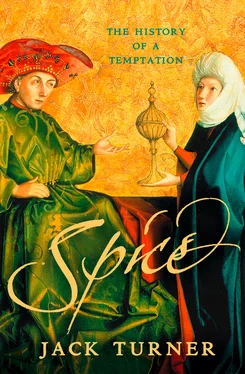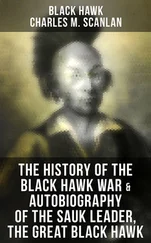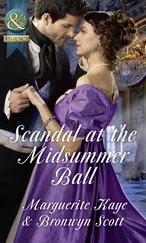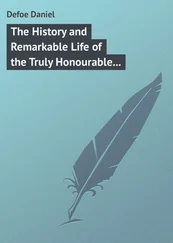*Nard is an aromatic plant of the Himalayas used in ancient perfumes and unguents. Calamus is an aromatic, semi-aquatic perennial herb, widely distributed from the Black Sea to Japan, put to similar purposes. Frankincense and myrrh are powerfully aromatic gum resins native to southern Arabia and the Horn of Africa. Frankincense was primarily used in ancient incense. Myrrh was put to purposes as diverse as incense, seasoning and embalming.
*Spices can be toxic to humans too if taken in sufficient quantities. Protracted overdoses of nutmeg can cause cancer of the liver.
*Sometimes also called Eugenia caryopbyllata.
I The Spice Race
When I discovered the Indies, I said that they were the richest dominion that there is in the world. I was speaking of the gold, pearls, precious stones, and spices, with the trade and markets in them, and because everything did not appear immediately, I was held up to abuse.
Christopher Columbus, letter from the third voyage, written from Jamaica, 7 July 1503
The Taste that Launched a Thousand Ships
According to an old Catalan tradition, the news of the New World was formally announced in the Saló del Tinell, the cavernous, barrel-vaulted banqueting hall in Barcelona’s Barri Gòtic, the city’s medieval quarter. And it is largely on tradition we must rely, for aside from a few sparse details the witnesses to the scene had frustratingly little to say, leaving the field free for painters, poets and Hollywood producers to evoke the moment that marks the watershed, symbolically at least, between medievalism and modernity. They have tended to imagine a setting of suitable grandeur, with king and queen presiding over an assembly of everyone who was anyone in the kingdom: counts and dukes weighed down by jewels, ermines and velvets; mitred bishops; courtiers stiff in their robes of state; serried ranks of pages sweating in livery. Ambassadors and dignitaries from foreign powers look on in astonishment and mixed emotions – awe, confusion and envy. Before them stands Christopher Columbus in triumph, vindicated at last, courier of the ecosystem’s single biggest piece of news since the ending of the Ice Age. The universe has just been reconfigured.
Or so we now know. But the details are largely the work of historical imagination, the perspective one of the advantages of having half a millennium to digest the news. The view from 1493 was less panoramic; indeed, altogether more foggy. It is late April, the exact day unknown. Columbus is indeed back from America, but he is oblivious to the fact. His version of events is that he has just been to the Indies, and though the tale he has to tell might have been lifted straight from a medieval romance, he has the proof to silence any who would doubt him: gold, green and yellow parrots, Indians and cinnamon.
At least that is what Columbus believed. His gold was indeed gold, if in no great quantity, and his parrots were indeed parrots, albeit not of any Asian variety. Likewise his Indians – the six bewildered individuals who shuffled forward to be inspected by the assembled company were not Indians but Caribs, a race soon to be exterminated by the Spanish colonisers and, deadlier still, by the germs they carried. The misnomer Columbus conferred has long outlived the misconception.
In the case of the cinnamon Columbus’s capricious labelling would not stick for nearly so long. A witness reported that the twigs did indeed look a little like cinnamon, but tasted more pungent than pepper, and smelled like cloves – or was it ginger? Equally perplexing, and most uncharacteristically for a spice, his sample had gone off during the voyage back – the unhappy consequence, as Columbus explained, of his poor harvesting technique. But in due course time would reveal a simpler solution to the mystery, and one that the sceptics perhaps guessed even then: that his ‘cinnamon’ was in fact nothing any spicier than the bark of an unidentified Caribbean tree. Like the Indies he imagined he had visited, his cinnamon was the fruit of faulty assumptions and an overcharged imagination. For all his pains Columbus had ended up half a planet from the real thing.
In April 1493, his wayward botany amounted to a failure either too bizarre or, for those whose money was at stake, too deflating to contemplate. As every schoolchild knows (or should know), when Columbus bumped into America he was looking not for a new world, but an old one. What exactly he was looking for is clearly delineated in the agreement he concluded before the voyage with the Spanish monarchs, promising the successful discoverer one tenth of all gold, silver, pearls, gems and spices. His posthumous fame notwithstanding, in this respect Columbus was only a qualified success. For in what in due course turned out to be the new world of the Americas, the conquistadors found none of the spices they sought, although in the temples and citadels of the Aztecs and Incas they stumbled across riches that out-glittered even the gilded fantasies they brought with them from Castile. Ever since, it is with the glitter of gold and silver, not the aroma of spices, that the conquistadors have been associated. But when Columbus raised anchor, and when he delivered his report in Barcelona, seated in the place of honour alongside the Catholic monarchs, ennobled and enriched for his pains, the perspective was different. The unimagined and unimaginable consequences of his voyage have clouded later views of causes, privileging half of the equation. Columbus sought not only an El Dorado but also, in some respects more beguiling still, El Picante too.
Why this was so may be answered with varying degrees of complexity. The simplest answer, but also the shallowest, is that spices were immensely valuable, and they were valuable because they were immensely elusive and difficult to obtain. From their harvest in distant tropical lands, spices arrived in the markets of Venice, Bruges and London by an obscure tangle of routes winding halfway across the planet, serviced by distant peoples and places that seemed more myth than reality. That this was so was as much a function of the geography as the geopolitics of the day. Where the spices grew – from the jungles and backwaters of Malabar to the volcanic Spice Islands of the Indonesian archipelago – Christians feared to tread. Astride the spice routes lay the great belt of Islam, stretching from Morocco to Indonesia. As spice was a Christian fixation so it was a Muslim milch cow. At every stage of the long journey from East to West a different middleman ratcheted up the price, with the result that by the time they arrived in Europe the value of the spices was astronomical, inflated in some cases to the order of 1,000 per cent – sometimes more. With cost came an aura of glamour, danger, distance and profit. Seen through European eyes, the horizon clouded by ignorance and vivified by imagination, the far-off places where the spices grew were the lands where money grew on trees.
Yet if the image was beguiling, the obstacles that stood in the way seemed insuperable – prior, that is, to Columbus. His solution was as elegant as it was radical. It was not inevitable, said Columbus, that Eastern goods should arrive from the east; nor that Westerners should pay such a premium, thereby lining the pockets of the infidel. The world being round, was it not simple logic that spices might also come around the other way: round the back of the globe, from the west? (Contrary to one hoary myth, hardly any informed medieval Europeans were flat-earthers. That the earth was spherical had been accepted by all informed opinion since ancient times.) All one had to do to reach the Indies and their riches was head west from Spain: the ancients had said so, but thus far no one had put the idea to the test. With a little endeavour spices would be as common as cabbages and herrings. Columbus, in not so many words, proposed to sail west to the East, to Cathay and the Indies of legend; or, in the words of one of his intellectual mentors, the Florentine humanist Toscanelli, ‘ ad loca aromatum ’, to the places where the spices are.
Читать дальше











